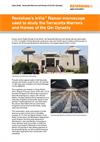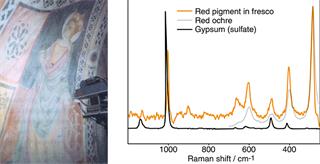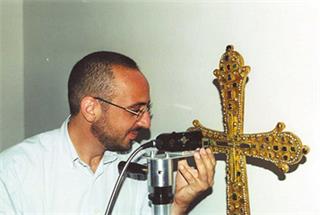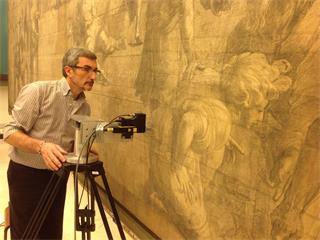Stran trenutno ni na voljo v vašem jeziku. Lahko si ogledate strojni prevod, ustvarjen s storitvijo Google Translate. Te storitve ne zagotavljamo mi in rezultatov prevoda nismo preverili.
Za dodatno pomoč se lahko obrnete na nas.
Art and heritage
Renishaw's Raman instruments have been involved in numerous investigations of cultural items, including, the Holy (Turin) Shroud, the Vinland map and a Chagall painting. In these, the ability to determine age and authenticity were vital.
Incredibly versatile
Renishaw's Raman systems can:
- analyse pigments and lacquers used in paintings, frescos, murals, and tapestries
- identify inks used in manuscripts, scrolls, maps and books
- investigate gemstones and minerals from cultural artefacts
- determine the constituents of papers, cloths and substrates
- determine authenticity and age by analysing the chemical nature of inks, pigments and lacquers
Preserve samples
Raman analysis is non-contacting and non-destructive, so you preserve your entire sample. You can take measurements in situ so there is no need to remove fragments for analysis.
Match that pigment
Use Renishaw's spectral databases to help you to identify pigments clearly and unambiguously. You can get started on analysis immediately, without having to create your own database; just add your own specific spectra later.
Analyse large samples
Large samples are no problem for Renishaw's Raman systems. If you can move your sample to an instrument, dedicated accessories, such as the flexible sampling arm, provide optimal sampling conditions. If you wish to house large items directly under the microscope, then our free-space microscopes will be of interest. You can customise our Raman systems and provide the right conditions for your analysis.
Analyse remotely
If moving your sample to a laboratory is impossible or impractical, we have a solution. Take Raman analysis capability to your sample and perform detailed in situ analysis though fibre optic probes.
We're here when you need us
To find out more about this application area, or an application that isn't covered here, contact our applications team.
Contact our applications team
Downloads: analytical sciences (art and heritage)
-
 Case study: Terracotta Warriors and Horses of the Qin Dynasty
Case study: Terracotta Warriors and Horses of the Qin Dynasty
Renishaw's inVia Raman microscope used to help identify pigments on the terracotta figures at Emperor Qin Shihuang's Mausoleum Site Museum in China
Related news
Renishaw's inVia used to study the Terracotta Warriors and Horses of the Qin Dynasty
Known as the ‘Eighth Wonder of the World', the Terracotta Warriors and Horses site was discovered in 1974. It consists of three figure pits covering an area over 20,000 square metres and forms part of Emperor Qin Shihuang's Mausoleum Site Museum, the largest imperial tomb in China.
Renishaw's inVia used in conservation activities at the Rijksmuseum in Amsterdam
The Rijksmuseum is the iconic museum of the Netherlands and in 2013, following extensive renovation and restoration, it re-opened its doors to the public. At the museum, art and history takes on a new meaning for a broad-based, contemporary national and international audience.






